Posted: October 30th, 2010 | Author: Nathan | Filed under: field recording, found sound objects, sound design
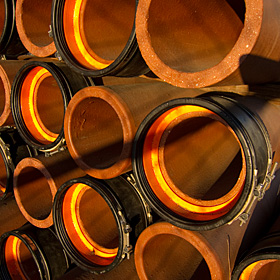
Pipes along the side of the road. This is the kind of "a-ha!" or "ooh!" moment recordists wait for!
[Just had to post something orange and slightly eerie. Happy Halloween, all!]
It was a quiet night in a San Francisco warehouse district: Calm wind, not a lot of people on the streets, the sun was going down. A bunch of pipes – probably for redoing water lines beneath the street – were stacked on the sidewalk, perpendicular to the street.
This is precisely the reason that I carry a small, handheld field recorder with me at all times. I shoved it into a few pipes to check out what I could hear. I got some really nice drones with that added pipe/tube resonance and comb filtering, which will definitely go in my growing and rather extensive “unsettling drone” library. Some of the car passbys in the street had a resonant, screaming quality, which may make good spaceship pass-bys as well, or aggressive layers for expressive car ‘bys.
But, I quite liked some of the passages where this drone mixed with the activity of the street. Today’s sound is recorded within a 12″ diameter concrete pipe about six feet long. A lone man walks down the street singing, followed by a bicycle, he continues singing then crosses the street in front of me, a breath of wind really amps up the resonance for a moment, and then a few cars pass by, kicking up loose asphalt. Although it sounds like a mix of street noise with a synth drone underneath it, this is unedited except for some compression and normalization. The imaging is incredibly tight because there was about six feet of 12″ pipe in front of the mic capsules, narrowing the stereo field.
[soundcloud url=”http://api.soundcloud.com/tracks/6555355″ params=”show_comments=true&auto_play=false&color=ee0000″ width=”100%” height=”81″ ]
[Sony PCM-D50 recorder, 90° capsule spread]
Tags: audio equipment, comb filtering, digital audio, field recording, pipe, resonance, singing, sound design, sound effects, tube, urban | 3 Comments »
Posted: October 28th, 2010 | Author: Nathan | Filed under: field recording, found sound objects

Beer, toiletries, ice chest, field recorders. Yep, that's a well-stocked camping trip!
The metal bearproof food locker is a common sight in the developed campgrounds of the Sierra Nevada mountains. They’re infamously noisy to open, close, and move things around in, and are usually the first sounds you hear in the morning. They do their job, though…provided you have them closed. I once had a close encounter with a bear whose head was stuck right into my slightly open bear locker (in my defense, it was in the midst of dinner preparation), but that’s another story for another blog.
I finally decided to record one on a trip this summer. It was a kayaking trip, so I had both my Zoom H2 [yeah, this is an older sound] and a hydrophone, so I decided to use both: The Zoom would get the stereo effects and the hydrophone would pick up the raw vibrations. I placed the H2 horizontally centered in the locker, and placed the hydrophone on the single shelf inside. Holy resonance, Batman!
Today’s sound is a collection of hits from this outdoors session, made with hands, metal objects, and a rubber mallet, first at normal pitch and then an octave lower. It wound up mixing rather well with my collection of shovel-in-wheelbarrow sounds from a while back. Get those subwoofers ready for the second half…
[soundcloud url=”http://api.soundcloud.com/tracks/6510828″ params=”show_comments=true&auto_play=false&color=ee0000″ width=”100%” height=”81″ ]
[Zoom H2 (120° capsule spread), Aquarian Audio H2a-XLR hydrophone into Sound Devices 702 recorder]
Tags: digital audio, field recording, found object, industrial, metal, microphone, percussion, sound design, sound effects | 8 Comments »
Posted: October 2nd, 2010 | Author: Nathan | Filed under: field recording
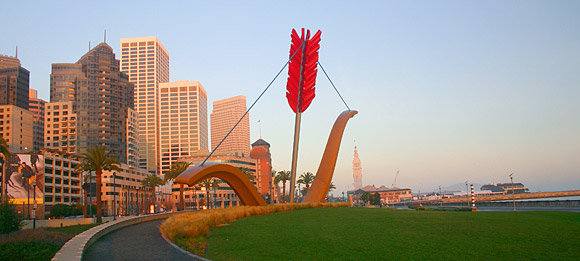
On this day, the City was quieter at 1pm than it was at dawn.
I work in San Francisco. It’s one of the world’s great urban centers. Imagine my surprise when I took the subway to the financial district and walked for two full blocks and heard…well, not much.
It was 1pm just off the Financial District on a weekday, and I heard almost no talking, no horns, and very few “hard sounds.” All that came to my ears was the occasional footsteps of a non-talkative passerby, the sound of a water jug being put on a hand truck, and of course traffic. There was plenty of sound, sure, but it was a wash of hushed tones, very diffuse and distant voices, nothing jarring like you’d expect near one of the great cities of the American West. On lunch hour, no less.
Here’s an example. I’m walking this whole clip, but wearing my quietest shoes (my sweet camo Chuck Taylors, if you must know), so any footsteps you hear are passers-by. This kind of hushed background ambience would be a great layer to which more specific hard effects could be added to achieve a certain mood.
[soundcloud url=”http://soundcloud.com/noisejockey/quiet-san-francisco” params=”show_comments=true&auto_play=false&color=dd0000″ width=”100%” height=”81″ ]
[Zoom H2 recorder]
Tags: ambience, digital audio, field recording, San Francisco, sound design, sound effects, urban | 3 Comments »
Posted: August 5th, 2010 | Author: Nathan | Filed under: field recording, nature recording
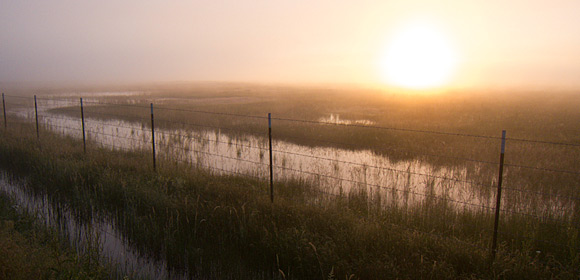
Somewhere in the murk there's quite a few noisy critters...
I originally considered this clip an outtake from the Nature Sounds Society Field Workshop this summer (which has been previously covered in older posts). I had never seen white-faced ibises before, and their ducklike honking and loud wing flaps were mixed in with local cows that were just waking up. It was about 7am.
But in listening to it again, I came to love the moment that was captured: Dense fog all around, the sun kissing vernal pools and long-grass marshland in the middle of the Sierra Nevada, and all the animals calling out to each other, re-establishing territory and familial bonds. I came to rather like the sound of the cows mixed in with the ibises, the swallows, and the blackbirds.
Field recordings don’t always have to be pristine to be interesting. Sometimes you must bend your mind to the material.
So, I’ll share it here today. Hang out until the very last bit, where an ibis takes off and flies overhead – great clarity in the call and the wing flaps.
[soundcloud url=”http://soundcloud.com/noisejockey/ibises-and-cows-in-sierra-valley” params=”show_comments=true&auto_play=false&color=dd0000″ width=”100%” height=”81″ ]
[Sennheiser MKH 50 and MKH 30 recorded as mid-side pair into Sound Devices 702 recorder]
Tags: birds, birdsong, digital audio, field recording, nature recording, Sierra Nevada, sound design, sound effects | 2 Comments »
Posted: July 30th, 2010 | Author: Nathan | Filed under: found sound objects, sound design

Brrrrwwwwaaaawwwrrrrrwwwaaar!
This might be harder to find at a thrift store than at an electronics or hobby store, but there are a large number of ultra-small toy helicopters on the market that can be had for not a lot of dosh. They’re flimsy. They don’t fly well. But they do scare the hell out of family pets, which instantly makes them entertaining, and they do make pretty cool sounds.
So, imagine this: You’re only one person with no assistants nearby. These helicopters, well, they fly erratically. How do you keep a mic trained on it to get a good recording? I solved this problem before by putting wireless mics on moving objects, but they’re far to heavy for something like this. Well, let’s just take advantage of the toy’s weak flying ability: Why not just hold the stupid thing while the rotors rotate? The rotors, however, rotate really quickly, and move a surprising amount of air. The body of the helicopter is so teensy that I couldn’t find a good mic position that blocked the air being moved around, which of course creates a lot of distortion and rumble.
Rather than futz around with a bulky windscreen and furry windjammer, I decided to just attach a contact microphone to the helicopter with gaffer’s tape. This worked reasonably well, especially after a quick equalization adjustment to overcome the somewhat dull midrange response of the mic itself. The sound that was transmitted through the high-density foam body was actually more interesting and full than the rotor’s sound in the free air, anyway. Besides the aforementioned EQ pass, this recording is unaltered. Recorded at 192kHz, this could provide all manner of mechanical effects if pitched down or processed further!
[soundcloud url=”http://soundcloud.com/noisejockey/toy-helicopter” params=”show_comments=true&auto_play=false&color=dd0000″ width=”100%” height=”81″ ]
[Contact microphone into Sound Devices 702 recorder]
Tags: digital audio, found object, helicopter, industrial, machine, sound design, sound effects, toy | 4 Comments »
Posted: July 27th, 2010 | Author: Nathan | Filed under: found sound objects, sound design
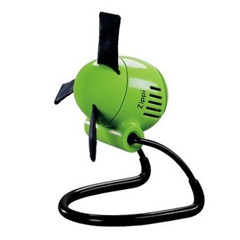
Meet Zippi: Suitable for propeller sounds of all kinds!
It’s been a long time since I’ve done a Thrift Store Sounds post, so let’s take a look at the nifty Vornado Zippi desktop fan!
It features soft cloth blades, a safety feature given the lack of a cage around the hub and its inevitable placement next to coffee mugs, iPads, and human fingers.
The motor’s not very powerful, and that’s really perfect for sound design. You can put your hand on the hub to slow it down. The soft blades let you stick all manner of wacky things in them without damaging the objects or the blades.
Today’s sound, then, is a short takes of sticking a ball-point pen into the fan blades. I think it’s great as a layering element for propeller sounds, be it a steampunk zeppelin or a toy/cartoon aircraft.
(If you want to hear more Thrift Store Sounds, be sure to check out recordings of a wicker basket and a shoe stretcher, or just use the Search too!)
[soundcloud url=”http://soundcloud.com/noisejockey/zippi” params=”show_comments=true&auto_play=false&color=dd0000″ width=”100%” height=”81″]
[OktavaMod MK-012 with cardioid cap, inside Rycote Baby Ball Gag windshield, into Sound Devices 702 recorder]
Tags: blade, digital audio, fan, found object, props, sound design, sound effects | 1 Comment »
Posted: July 22nd, 2010 | Author: Nathan | Filed under: field recording, found sound objects
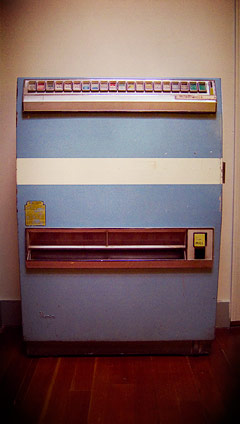
Mmm, so many tasty, carcinogenic choices.
Like over 100 other field recordists, I signed up for Tim Prebble’s crowdsourced special effects library of doors from around the world on his boutique effects label, Hiss and a Roar.
Unfortunately, due to extenuating circumstances, I had to bow out of the project, and a number of other side-projects. (Saying “no” is a powerful tool to help rein in your life from your own over-committal. Just do it early enough.)
However, one of the more interesting doors I did manage to record was the hinged front panel of an all-metal, 1970’s-era cigarette vending machine. This thing lives in my office, inherited from previous tenants. It’s too big to get rid of, and too odd and ironic to let go of, since none of us smoke. This object has been heard here before.
In honor of the awesome work everyone has done on this upcoming release, today’s sound is a fragment of my own aborted contribution, in the hopes that everyone will support Hiss and a Roar and pick up the collection when it’s released.
[soundcloud url=”http://soundcloud.com/noisejockey/cigmachinedoorslams” params=”show_comments=true&auto_play=false&color=dd0000″ width=”100%” height=”81″ ]
[Sennheiser MKH 50/30 mid-side stereo pair with into Sound Devices 702 recorder]
Tags: creak, digital audio, door, field recording, found object, machine, metal, sound design, sound effects | 8 Comments »
Posted: July 14th, 2010 | Author: Nathan | Filed under: field recording, found sound objects, sound design
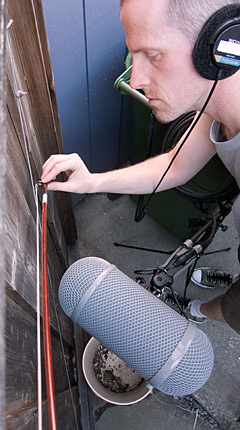
Noise Jockey: Taking the "E" out of "e-bow."
Almost exactly one year ago, I played a steel cable on a gate with an eBow , recorded with contact microphones. I decided to give it a go with a regular bow when I realized that this gate was basically a one-stringed guitar.
, recorded with contact microphones. I decided to give it a go with a regular bow when I realized that this gate was basically a one-stringed guitar.
Think about it: Wound metal string under tension, wooden resonator. That’s all a guitar really is. What a wooden gate lacks is thickness, like a guitar, but at more than a meter in width and height, that’s a broad-enough surface to send air molecules running for cover.
I had to rosin the hell out of the bow to make it tacky enough to grip this oversized “string.” I found that also spreading rosin on the wrapped steel cable was helpful. I tuned the cable, as much as one can, by adjusting a turnbuckle.
I recorded in mid-side stereo. Today’s sample features is comprised of one mono track totally dry, one mono track run through Michael Norris’ Spectral Blurring effect, one mono track pitch-shifted down by 1.5 octaves, and the one stereo track pitch-shifted down by three octaves. Recording at 192Hz helps for such tomfoolery.
I apologize to my neighbhors for the unholy racket that I’m sure they thought was a demonic violin 101 class.
[soundcloud url=”http://soundcloud.com/noisejockey/satans-violin-lesson” params=”show_comments=true&auto_play=false&color=dd0000″ width=”100%” height=”81″ ][Sennheiser MKH 50 and MKH 30 recorded as mid-side stereo into Sound Devices 702 recorder]
Tags: digital audio, drone, experimental, field recording, found object, industrial, metal, mid side, sennheiser, sound design, sound effects, violin bow | 5 Comments »
Posted: July 9th, 2010 | Author: Nathan | Filed under: field recording, gear, nature recording

Lookit that man out there. He's quite a dish.
One of the best reasons to spend a weekend with other sound recordists is a chance to try out new gear. A classic nature recording technique is the use of a microphone set in a parabolic dish.
The general public knows of parabolics mostly from seeing people use them on the sidelines of sporting events. In nature recording, they’re for capturing species-specific sounds rather than ambiences. This is because the microphones in parabolic dishes are mono, and have sound pushed into them by the dish itself. This creates a very narrow “beam” of listening. Perceptually, parabolics seem like they “zoom in” on sounds, but this is simply due to such microphones just attenuating all the sounds outside that narrow cone.
Parabolics are also interesting because the frequency response is directly tied to the size of the dish. For most song birds, this is fine. Besides, making and transporting a 17-meter-wide dish just to get a 20Hz-20kHz frequency response just seems silly. At that point, you’re practically into SETI territory! :-)
I got the chance to use one at the Nature Sounds Society Field Workshop. The unit you see in the photo above was the one used by the founder of the NSS, Paul Matzner, so I was holding a bit of history: Hand-made of fiberglass and aluminum, the NSS archives have lots of photos with Matzner holding this thing. Had I looked at the archives before heading into the field, I’d have gotten a way better handling technique. Holding it by its edges introduced horrendous amounts of handling noise.
Today’s sound is from this unit, recorded at 5:01am at Yuba Pass, off California Route 49. As far as I can tell, this is a chestnut-backed chickadee. You can tell, even in this recording, he’s got a lot of pals around (woodpeckers and sparrows at least).
[soundcloud url=”http://soundcloud.com/noisejockey/chestnut-backed-chickadee-yuba-pass-ca” params=”show_comments=true&auto_play=false&color=dd0000″ width=”100%” height=”81″ ]
[DPA 4006 omni microphone in custom 1m parabolic dish into Sound Devices 702 recorder]
Tags: audio equipment, birds, birdsong, digital audio, field recording, microphone, nature, nature recording, parabolic dish, Sierra Nevada, sound effects | 4 Comments »
Posted: July 3rd, 2010 | Author: Nathan | Filed under: field recording, gear, nature recording
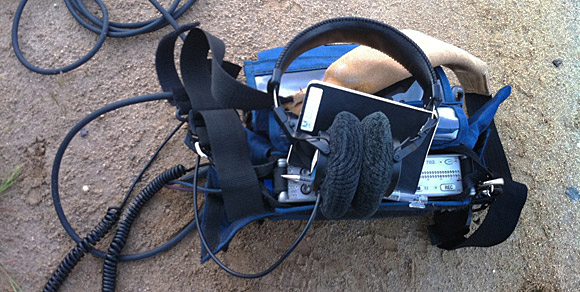
Neither dirt, nor fog, nor clouds of mosquitos keeps a field recordist from his crack-of-dawn tasks!
I’m finally unpacked and rested from the inspiring (and exhausting) 26th Annual Nature Sounds Society Field Workshop in California’s Sierra Nevada. Since my last post was a compilation of high-level personal experiences, I thought that I’d report back about what worked, or didn’t work, in the field on the technology side of things…as well as share a recording from our first early-morning field session.
- Outdoor Gear. My REI trail stool was instrumental in keeping my body still (I can be a fidgety so-and-so), the importance of which can’t be understated when your preamp gain is at 80% of maximum and you can hear birds’ wing flaps 20 meters away. [Hint: For nature recording, more layers of softer materials – like fleece, soft-handed polyester, and wool - are the best for staying warm and silent. Consider gaffer-taping your metal zippers, too!]
- Microphones. My primary MKH 50/30 rig performed brilliantly, with a strong signal-to-noise ratio even in the quietest moments. I also got a chance to try out a rather large parabolic microphone…more on that in a later post. [Hint: If you want a mic for nature recording, you need to be looking in the <-16dBA self-noise range, the lower the better.]
- Recorders. The ol’ 702 worked its usual wonders. I monitored as mid-side in the field, only converting to left/right once I returned. A +8dB side signal using Tom Erbe’s +Matrix plug-in made for a wide, enveloping sense of space without losing center imaging. Â [Hint: Batteries drain faster when cold. Store spares inside your jacket, or in your sleeping bag with you overnight!]
The gear list across everyone was pretty insane: many Olympus LS10 recorders, several Sound Devices 744T’s, a Sony PCM-D50, and mics from DPA, Neumann, Røde, Sennheiser, and Telinga. Recording techniques varied from mono to mid-side stereo, XY stereo, ORTF, Jecklin discs, and even two binaural dummy-head rigs (see this site for a good explanation of all this alphabet soup). An outdoor mic directionality seminar helped to illustrate what each is good for, which was a rare opportunity and extremely educational.
Yeah, yeah, whatever. But what did it sound like?
Today’s sound was recorded around 5:45am on a day with a slight breeze and scads of ground fog. The location was Sierra Valley, north of state route 49 in the Sierra Nevada. This recording includes at least swallows (cave or barn, I’m unsure), American bitterns, red-winged blackbirds, white-faced ibises, yellow-faced blackbirds, and a bullfrog, and certainly more that I can’t identify.
Get those headphones on and close your eyes…
[soundcloud url=”http://soundcloud.com/noisejockey/amb-bird-dawnchorus-sierravalley-01″ params=”show_comments=true&auto_play=false&color=dd0000″ width=”100%” height=”81″ ]
[Sennheiser MKH 50 and MKH 30 recorded as mid-side pair into Sound Devices 702 recorder]
Tags: audio equipment, birds, birdsong, camping, digital audio, field recording, microphone, nature, nature recording, Sierra Nevada, sound design, sound effects | 5 Comments »









